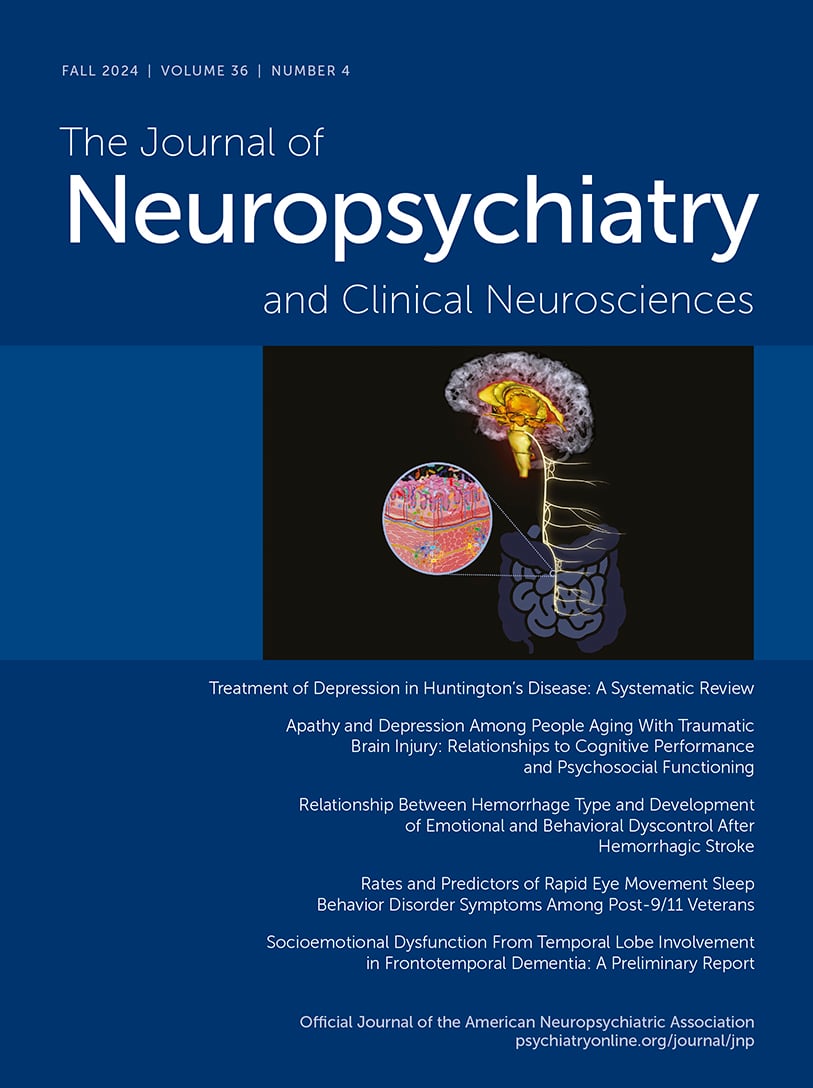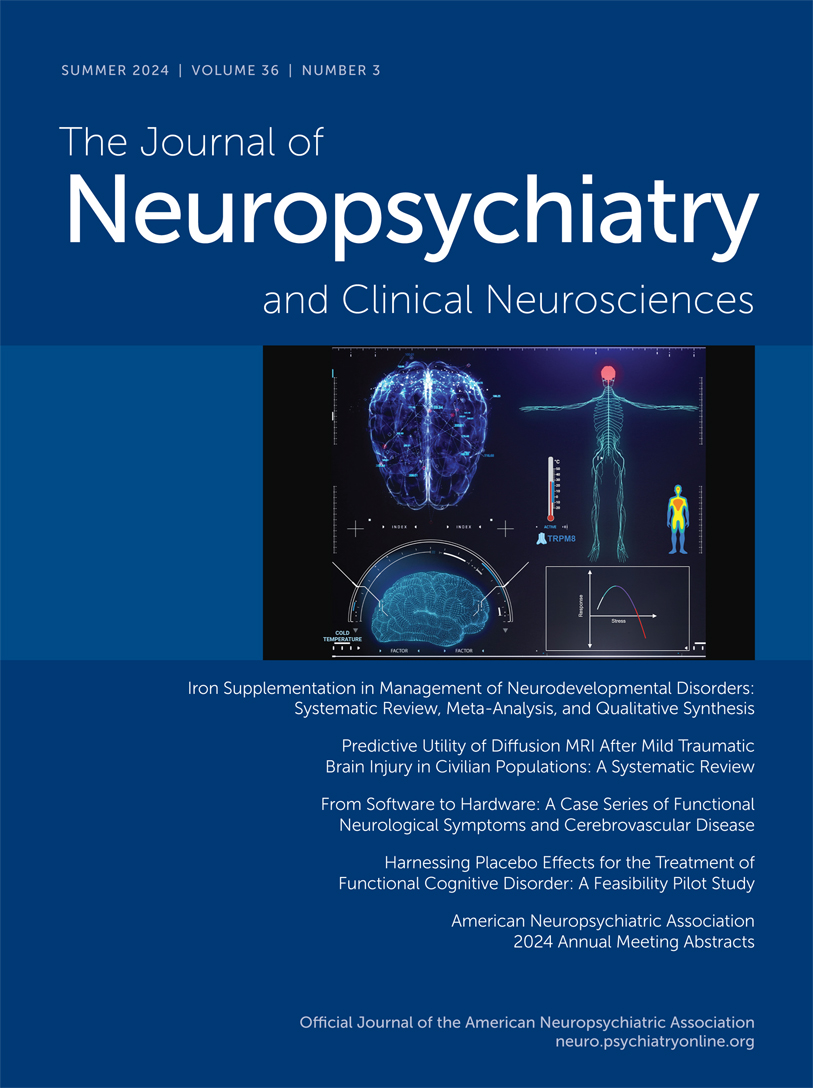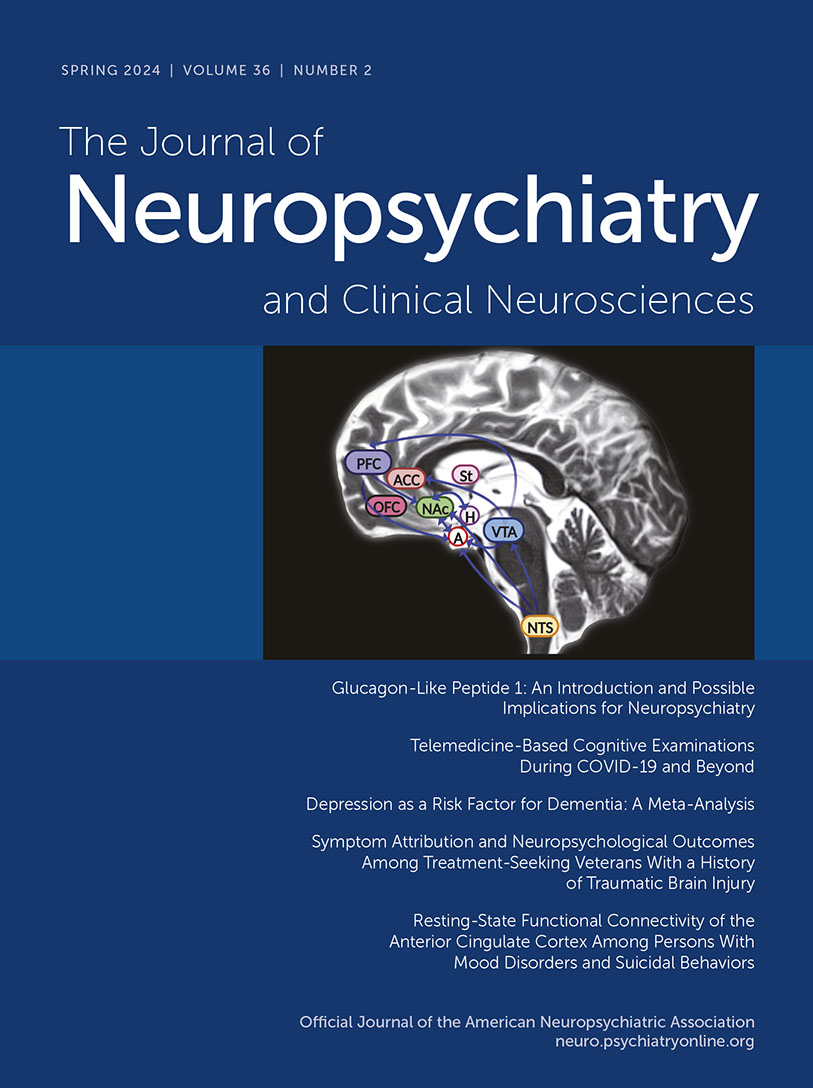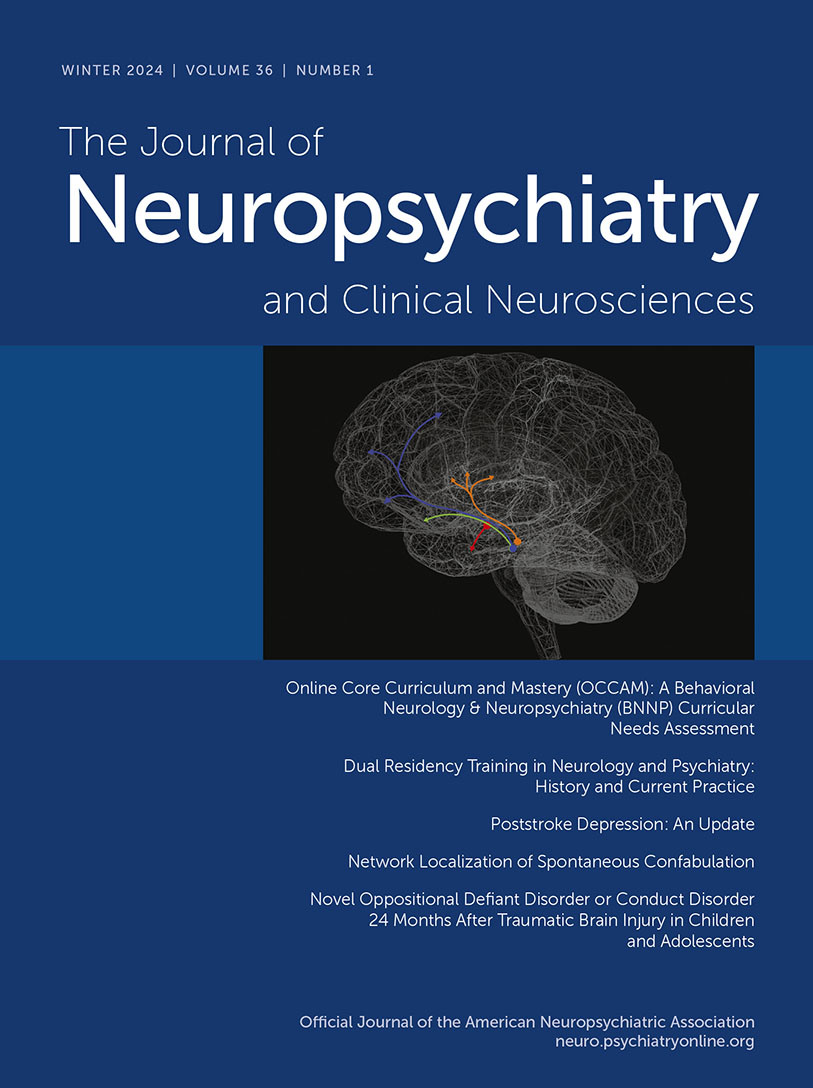The Journal of Neuropsychiatry and Clinical Neurosciences
- Volume 27
- Number 1
- January 2015
Windows to the Brain
Features
Special Articles
Publication date: 01 January 2015
Pages7–18Adaptive behavior requires neural systems that mediate the evaluation of stimuli in terms of the well-being of the organism and generate subsequent goal-directed behavior. The authors provide an overview of these systems, with an emphasis on those related ...
https://doi.org/10.1176/appi.neuropsych.13120370Publication date: 01 January 2015
Pages19–26Deep brain stimulation (DBS) of the subthalamic nucleus (STN) is an established treatment for the motor symptoms of Parkinson’s disease (PD). Nonmotor features of PD, however, may not improve with STN DBS, and a specific constellation of neuropsychiatric ...
https://doi.org/10.1176/appi.neuropsych.14040069Features
Regular Articles
Publication date: 01 January 2015
Pages27–32The authors investigated whether male violent juvenile offenders demonstrate any differences in local functional connectivity indicative of delayed maturation of the brain that may serve as a biomarker of violence. Twenty-nine violent juvenile offenders ...
https://doi.org/10.1176/appi.neuropsych.13030044Publication date: 01 January 2015
Pages33–41Gilles de la Tourette syndrome and conduct disorder (CD) are both heterogeneous childhood onset conditions, and although patients with CD have been described in Gilles de la Tourette syndrome cohorts, little is known about the etiology of CD in Gilles de ...
https://doi.org/10.1176/appi.neuropsych.13050112Publication date: 01 January 2015
Pages42–47Behavioral symptoms are known to be a prominent feature of Gilles de la Tourette syndrome (GTS), although little is known about irritability in this patient population. This study investigated the clinical correlates of irritability symptoms in 101 adult ...
https://doi.org/10.1176/appi.neuropsych.13060143Publication date: 01 January 2015
Pages48–53Deficits in prepulse inhibition (PPI) and cannabis abuse are consistently found in schizophrenia. The authors studied PPI deficits in first episode psychosis (FEP) with schizophrenia and cannabis abuse influence. Thirty-five patients with FEP and 22 ...
https://doi.org/10.1176/appi.neuropsych.12120398Publication date: 01 January 2015
Pages54–58The authors aimed to determine the prevalence of antineuronal antibodies in 103 psychiatric inpatients and 41 control subjects with no history of malignancies or neurological disorders. All sera were tested by indirect immunofluorescence and positive sera ...
https://doi.org/10.1176/appi.neuropsych.13070153Publication date: 01 January 2015
Pages59–64The authors report the inter-rater reliability and factor structure of the Short Problem Behaviors Assessment (PBA-s), a semistructured interview to measure severity and frequency of behavioral problems in Huntington’s disease. Video recordings of 410 PBA-...
https://doi.org/10.1176/appi.neuropsych.13070169Features
Clinical and Research Reports
Publication date: 01 January 2015
Pages65–68In a chart review of patients with obsessive-compulsive disorder (OCD) attending a university clinic, ECT was prescribed for five subjects (1.2%), only because of severe intervening manic (N=1) or depressive episodes (N=4). Although affective symptoms ...
https://doi.org/10.1176/appi.neuropsych.13080184Publication date: 01 January 2015
Pages69–71The authors examined the frequency of neuroimaging findings of cortical atrophy and/or cerebrovascular disease in patients with delirium with hypovitaminosis D and normal vitamin D levels. Of 32 patients with delirium with hypovitaminosis D who were ...
https://doi.org/10.1176/appi.neuropsych.13060121Publication date: 01 January 2015
Pages72–73Wilson’s disease, characterized by abnormal copper accumulation in the human body, may present with psychiatric manifestations in about one-fifth of patients. The authors report a patient with Wilson’s disease who initially presented with acute psychosis ...
https://doi.org/10.1176/appi.neuropsych.13120362Online Exclusives
Publication date: 01 January 2015
Pagese1–e9This study utilized functional magnetic resonance imaging (fMRI) to discriminate brain activation patterns associated with the effect of distraction during working memory (WM) maintenance for human faces in healthy controls and patients with ...
https://doi.org/10.1176/appi.neuropsych.13080177Publication date: 01 January 2015
Pagese10–e13The authors retrospectively reviewed the clinical records of 196 patients with dementia treated with memantine for at least 6 months. Eleven (5.6%) developed treatment-induced agitation. At chi-square analysis, they were significantly more likely to have ...
https://doi.org/10.1176/appi.neuropsych.13100226Publication date: 01 January 2015
Pagese14–e16This is a report on two cases of refractory schizophrenia and two cases of clozapine-resistant schizophrenia successful treated with paliperidone palmitate. To the authors’ knowledge, this is the first report of the successful use of paliperidone ...
https://doi.org/10.1176/appi.neuropsych.13120374Publication date: 01 January 2015
Pagese17–e21Tabes dorsalis (TD) was documented as the most common parenchymal neurosyphilis, but its incidence dramatically declined in the antibiotic era. Syphilis has resurged on the China mainland since the 1980s. In recent years, physicians have been reporting ...
https://doi.org/10.1176/appi.neuropsych.13100303Publication date: 01 January 2015
Pagese22–e27Apathy is a common neuropsychiatric symptom in Alzheimer’s disease dementia and amnestic mild cognitive impairment and is associated with cortical atrophy in Alzheimer’s disease dementia. This study investigated possible correlations between apathy and ...
https://doi.org/10.1176/appi.neuropsych.13060141Publication date: 01 January 2015
Pagese28–e31Mortality because of epilepsy is a major concern worldwide. People with epilepsy have a two to three times increased risk of death in comparison with the general population. Sudden unexplained death in epilepsy is a mysterious, rare condition, in which ...
https://doi.org/10.1176/appi.neuropsych.13120366Publication date: 01 January 2015
Pagese32–e39Deficits in emotional processing may be attributed to HIV disease or comorbid psychiatric disorders. Electrocortical markers of emotional attention, i.e., amplitude of the P2 and late positive potential (LPP), were compared between 26 HIV+ women and 25 ...
https://doi.org/10.1176/appi.neuropsych.13090222Publication date: 01 January 2015
Pagese40–e50Although somatosensory amplification is theorized to serve a critical role in somatization, it remains poorly understood neurobiologically. In this perspective article, convergent visceral-somatic processing is highlighted, and neuroimaging studies in ...
https://doi.org/10.1176/appi.neuropsych.13070170Publication date: 01 January 2015
Pagese51–e53Musical hallucinations are a rare phenomenon that renders appropriate identification and treatment a challenge. This case series describes three women who presented with hearing complex, familiar melodies in the absence of external stimuli on a background ...
https://doi.org/10.1176/appi.neuropsych.13110327Publication date: 01 January 2015
Pagese54–e59The objective of this study was to compare the anticraving efficacy of high-frequency repetitive transcranial magnetic stimulation (rTMS) of the right versus left dorsolateral prefrontal cortex (DLPFC) in patients with alcohol dependence. Twenty patients ...
https://doi.org/10.1176/appi.neuropsych.13010013Departments
Letters
Past Issues
View Issues Archive
Vol. 36 | No. 4

Vol. 36 | No. 3

Vol. 36 | No. 2
